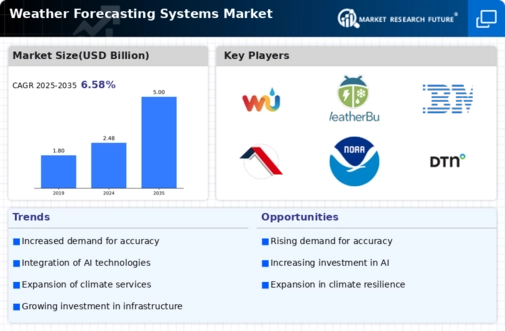Top Industry Leaders in the Weather Forecasting Systems Market

Strategies Adopted:
Advanced Technology Adoption: Key players invest in advanced technologies such as artificial intelligence, machine learning, and big data analytics to improve the accuracy and reliability of weather forecasting models.
Data Integration: Companies focus on integrating data from various sources including satellites, weather stations, drones, and IoT devices to enhance the precision and granularity of weather forecasts.
Customized Solutions: Offering customized weather forecasting solutions tailored to specific industries such as agriculture, aviation, energy, and transportation helps companies address unique customer requirements and gain a competitive edge.
Expansion of Services: Diversifying service offerings to include not only weather forecasts but also real-time alerts, risk assessment tools, and decision support systems enables companies to provide comprehensive solutions to clients.
Key players include:
Oxley Developments Company Ltd,
Astronics,
Orion Energy Systems, Inc.,
Carmanah Technologies Corporation,
Zumtobel AG,
Dialight PLC,
Revolution Lighting Technologies,
Laminators technologies,
United Technologies,
Lunar Lighting, Honeywell,
Acuity Brand Lighting,
Osram Licht AG, Cree Inc.,
Larson Electronics,
Deco Lighting,
Cooper Industries PLC, and
G.E. Lightings.
Factors for Market Share Analysis:
Accuracy and Reliability: Companies with a track record of providing accurate and reliable weather forecasts gain market share by earning the trust of customers, especially those in sectors where weather impacts operations significantly.
Global Coverage: Key players with a global presence and comprehensive coverage of weather data across different regions are better positioned to serve multinational clients and capture market share in diverse geographic markets.
Industry Expertise: Providers with specialized expertise in specific industries, such as agriculture, aviation, or maritime, are preferred by customers seeking tailored weather solutions, driving market share growth within niche sectors.
Innovation and Technology Leadership: Companies leading in innovation and technology adoption, with a focus on developing cutting-edge forecasting models and tools, attract customers seeking state-of-the-art solutions, thereby increasing market share.
New and Emerging Companies:
Tomorrow.io (formerly ClimaCell) - US
Tomorrow.io - Israel
Tomorrow.io - United Kingdom
Tomorrow.io - France
Tomorrow.io - Germany
Tomorrow.io - Japan
Tomorrow.io - South Korea
Tomorrow.io - Australia
Tomorrow.io - India
Tomorrow.io - Brazil
Industry News:
Advancements in Forecasting Models: News about advancements in weather forecasting models, algorithm improvements, and breakthroughs in predictive analytics highlight companies' efforts to enhance forecast accuracy and reliability.
Strategic Partnerships: Collaborations between weather forecasting companies and industry stakeholders, such as airlines, agriculture companies, and energy utilities, to develop customized solutions and provide value-added services drive market growth and competitiveness.
Expansion into New Markets: Reports of companies expanding into new geographic markets or vertical industries signify efforts to broaden their customer base, increase market share, and capitalize on emerging opportunities.
Investment in R&D: Announcements of investments in research and development initiatives, including the development of new technologies, acquisition of data sources, and talent acquisition, underscore companies' commitment to innovation and market leadership.
Current Company Investment Trends:
Artificial Intelligence and Machine Learning: Investments in AI and ML technologies for weather prediction algorithms, pattern recognition, and data analysis enhance forecast accuracy and enable the development of real-time predictive models.
High-Resolution Weather Data: Investments in high-resolution weather data collection and processing capabilities, including satellite imagery, radar systems, and ground-based sensors, improve the granularity and precision of weather forecasts.
Mobile and IoT Integration: Companies are investing in mobile apps and IoT devices that provide real-time weather updates and personalized alerts to end-users, leveraging the ubiquity of smartphones and connected devices to deliver weather information anytime, anywhere.
Climate Change Adaptation: Investments in climate change adaptation strategies, including the development of climate resilience tools, risk assessment frameworks, and mitigation strategies, address growing demand for weather-related solutions in the face of changing climate patterns.




